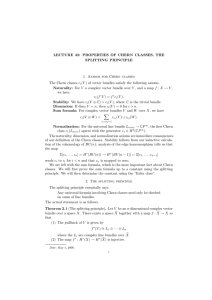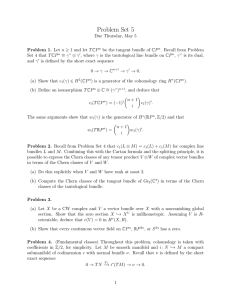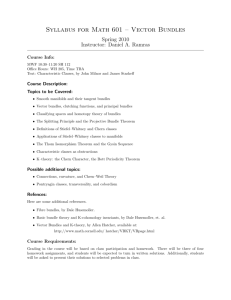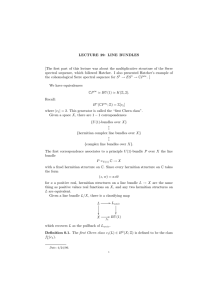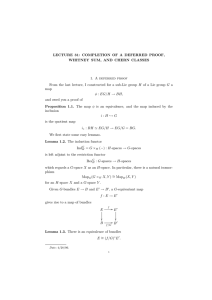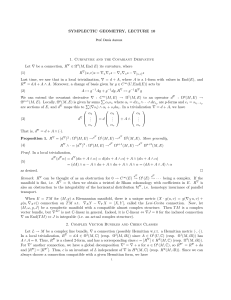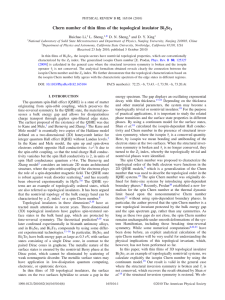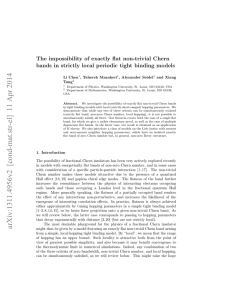SYMPLECTIC GEOMETRY, LECTURE 11 → Let E
advertisement
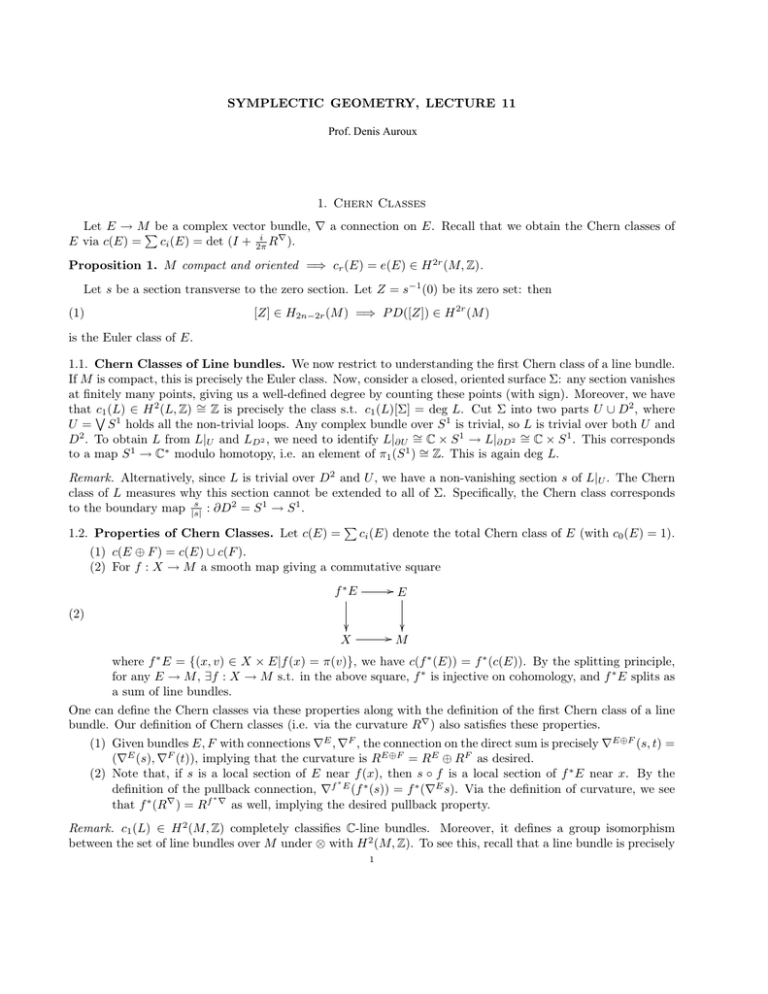
SYMPLECTIC GEOMETRY, LECTURE 11
Prof. Denis Auroux
1. Chern Classes
Let E → M�be a complex vector bundle, � a connection on E. Recall that we obtain the Chern classes of
i
E via c(E) = ci (E) = det (I + 2π
R� ).
Proposition 1. M compact and oriented =⇒ cr (E) = e(E) ∈ H 2r (M, Z).
Let s be a section transverse to the zero section. Let Z = s−1 (0) be its zero set: then
(1)
[Z] ∈ H2n−2r (M ) =⇒ P D([Z]) ∈ H 2r (M )
is the Euler class of E.
1.1. Chern Classes of Line bundles. We now restrict to understanding the first Chern class of a line bundle.
If M is compact, this is precisely the Euler class. Now, consider a closed, oriented surface Σ: any section vanishes
at finitely many points, giving us a well-defined degree by counting these points (with sign). Moreover, we have
that �
c1 (L) ∈ H 2 (L, Z) ∼
= Z is precisely the class s.t. c1 (L)[Σ] = deg L. Cut Σ into two parts U ∪ D2 , where
1
U = S holds all the non-trivial loops. Any complex bundle over S 1 is trivial, so L is trivial over both U and
D2 . To obtain L from L|U and LD2 , we need to identify L|∂U ∼
= C × S 1 → L|∂D2 ∼
= C × S 1 . This corresponds
1
∗
1 ∼
to a map S → C modulo homotopy, i.e. an element of π1 (S ) = Z. This is again deg L.
Remark. Alternatively, since L is trivial over D2 and U , we have a non-vanishing section s of L|U . The Chern
class of L measures why this section cannot be extended to all of Σ. Specifically, the Chern class corresponds
to the boundary map |ss| : ∂D2 = S 1 → S 1 .
�
1.2. Properties of Chern Classes. Let c(E) = ci (E) denote the total Chern class of E (with c0 (E) = 1).
(1) c(E ⊕ F ) = c(E) ∪ c(F ).
(2) For f : X → M a smooth map giving a commutative square
(2)
f ∗E
�E
�
X
�
�M
where f ∗ E = {(x, v) ∈ X × E|f (x) = π(v)}, we have c(f ∗ (E)) = f ∗ (c(E)). By the splitting principle,
for any E → M , ∃f : X → M s.t. in the above square, f ∗ is injective on cohomology, and f ∗ E splits as
a sum of line bundles.
One can define the Chern classes via these properties along with the definition of the first Chern class of a line
bundle. Our definition of Chern classes (i.e. via the curvature R� ) also satisfies these properties.
(1) Given bundles E, F with connections �E , �F , the connection on the direct sum is precisely �E⊕F (s, t) =
(�E (s), �F (t)), implying that the curvature is RE⊕F = RE ⊕ RF as desired.
(2) Note that, if s is a local section of E near f (x), then s ◦ f is a local section of f ∗ E near x. By the
∗
definition of the pullback connection, �f E (f ∗ (s)) = f ∗ (�E s). Via the definition of curvature, we see
∗
that f ∗ (R� ) = Rf � as well, implying the desired pullback property.
Remark. c1 (L) ∈ H 2 (M, Z) completely classifies C-line bundles. Moreover, it defines a group isomorphism
between the set of line bundles over M under ⊗ with H 2 (M, Z). To see this, recall that a line bundle is precisely
1
Prof. Denis Auroux
2
∼
=
a collection of local trivializations {fα : L|Uα → Uα × C} with attaching maps gα,β ∈ C ∞ (Uα ∩ Uβ , C∗ ) satisfying
the cocycle condition
gα,β gβ,γ gγα = 1
(3)
on Uα ∩ Uβ ∩ Uγ . This corresponds precisely with the Cech cohomology on M , where {gα,β } is a 1-cocycle. In
this description, c1 is the connecting map in the long exact sequence
(4)
· · · → 0 = H 1 (M, C) → H 1 (M, C∗ ) →c1 H 2 (M, Z) → H 2 (M, C) = 0 → · · ·
exp
associated to the short exact sequence of sheaves 0 → Z → C → C∗ → 0 where C, C∗ are the sheaves of C∞
functions with values in C, C∗ . One can also see directly the fact that c1 (L ⊗ L� ) = c1 (L) + c1 (L� ) using the
�
�
definition of the tensor product connection �L⊗L = �L ⊗ id + id ⊗ �L .
Now, for (M, ω) a symplectic manifold, J a compatible almost-complex structure, (T M, J) is a complex vector
bundle, with cj (T M ) ∈ H 2j (M, Z). Since the RHS is discrete, we get an invariant of the almost-complex
structure up to deformation, and since the space of compatible J’s is connected, the complex isomorphism
class of (T M, J) is uniquely determined. Explicitly, if Jt is a family of complex structures on E, the map
φ : v �→ 12 (v − Jt Jt0 v) is a complex isomorphism from (E, Jt0 ) to (E, Jt ) since
1
1
(Jt v + Jt v) = Jt ( (v − Jt Jt0 v)) = Jt φ(v)
2 0
2
Thus, cj (T M, J) is independent of the choice of almost-complex structure (it is even an invariant of the de­
formation class of M ): for instance, cn (T M ) ∈ H 2n (M, Z) ∼
= Z is an invariant of the manifold (the Euler
characteristic).
(5)
φ(Jt0 v) =
Remark. For 1 ≤ j ≤ n − 1, cj does depend on the choice of symplectic structure, however: there exists a
4-manifold M with symplectic forms ω1 , ω2 s.t. c1 (T M, ω1 ) �= c1 (T M, ω2 ).
